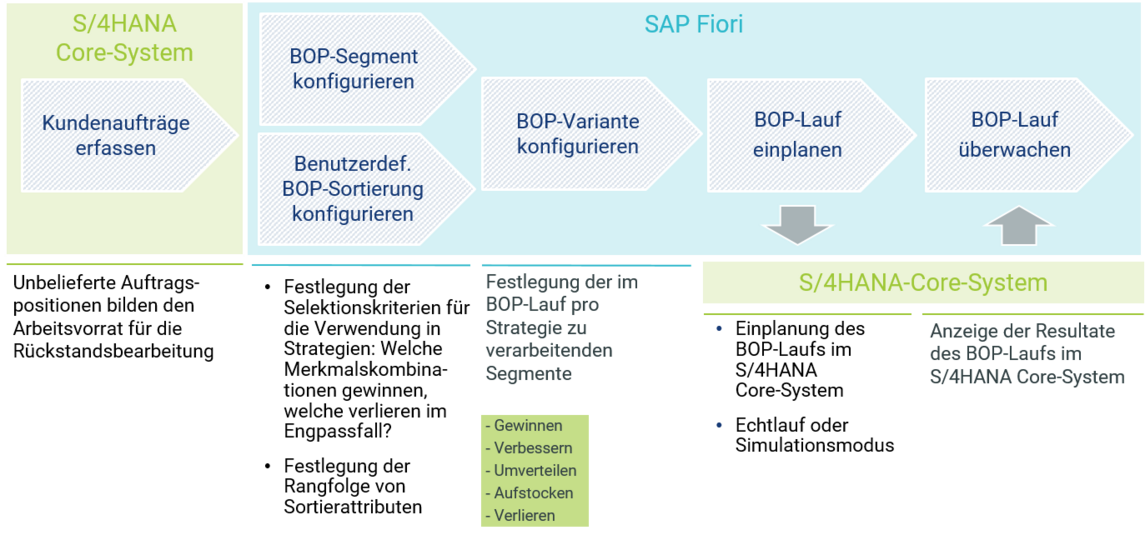Advanced ATP – Backorder Processing with S/4HANA
How you can distribute bottleneck quantities to a defined group of customers according to flexible rules
Are you familiar with this situation? Customer orders are in backlog and quantities that become available should be distributed to these orders according to flexibly definable rules. Or reserved quantities of existing sales orders should be redistributed to other orders if priorities change.
In the SAP ERP environment, such requirements are normally covered by the simple, less flexible transactions for backorder processing and rescheduling. These are also available under S/4HANA, but offer no additional options there.
At the other end of the performance spectrum, the SCM-APO functionality of Backorder Processing (BOP) leaves nothing to be desired in terms of functionality, but is complex to configure and often not an option due to the additionally required SCM system.
In practice, rescheduling is therefore usually carried out with a simple, periodically scheduled background run, while single-case-related exceptions are implemented in a time-consuming manner using manual backlog processing. The simultaneous change of a large number of documents is not possible due to the high processing effort. Overall, this is not a satisfactory situation.
On one hand, you want to keep the effects of delivery bottlenecks and backlogs as low as possible in order to avoid disruptions in customer relations. On the other hand, the effort required to process backlogged customer orders is often very high.
Would you as a user like to have a greater influence on the parameterization of rescheduling and backorder processing than the ERP standard allows? Or do you need a more flexible user interface and more extensive simulation functions?
This is exactly where the new S/4HANA solution Backorder Processing (BOP) comes into play as a component of the new extended availability check (AATP).
The new AATP residue processing combines the openness and flexibility of SCM APO functionality with a flexible and intuitive user interface. This makes it easy for you to handle requirements arising from the distribution of bottleneck quantities.

Strengthen customer loyalty with AATP Backorder Processing This is how we support you:
- We will introduce you to the possibilities offered by AATP-BOP in S/4HANA and what the added value is compared to conventional backorder processing based on SAP ERP.
- We will discuss with you which basic conditions have to be considered when introducing an AATP-BOP solution in your company and which infrastructure requirements have to be met.
- We work with you to develop a schedule for implementation.
- We implement the AATP-BOP solution in your test environment in the form of a proof of concept and train the users involved in the project.
- We assist you in testing the implemented solution and, if necessary, adapt it to the specific requirements of your company.
- The transfer of AATP-BOP into the productive environment is usually carried out at an early stage, since the solution has extensive simulation functions and all settings can be fine-tuned during operation.
- Our experts are there to assist you in all these phases with advice and practical support. We support you in design, infrastructure provision, system setup and training. We will guide you through all stages of the implementation project - and afterwards, if you wish.

Use your advantages.
Seven good reasons for a cooperation with CONSILIO:
- We know all areas in detail in which AATP Backorder Processing in S/4HANA differs from the former ERP and SCM APO solution.
- We offer practice-oriented support in selecting the optimal solution for you, taking into account the functional requirements, the importance of the issue of rescheduling in your business field and your current licensing situation.
- We support the implementation of a backorder processing solution in S/4HANA within the framework of a coaching approach, but we are also happy to carry this out ourselves as the responsible implementation partner. From project organization and training of project members/end users to ramp-up support after going live - you decide when you need us!
- Our approach is practice-oriented, because we know the technical requirements for availability checks and backorder processing from a large number of customer projects in detail. Due to our expertise in the production and sales environment, the topic of availability is often a central component of our projects.
- We follow the implementation methodology of our customers and thus enable lean projects. Or we bring the implementation methodology with us - just as you wish.
- We ensure a fast implementation of your ideas in terms of backorder processing. Typically, AATP Backorder Processing projects can be implemented in a few days, since the final definition of the rules to be applied can be made in the ramp-up phase during productive operation. In this process, you will be optimally supported by the extensive simulation and logging functions of the new AATP.
- We help you to provide and set up the necessary infrastructure, if it is not yet available.

